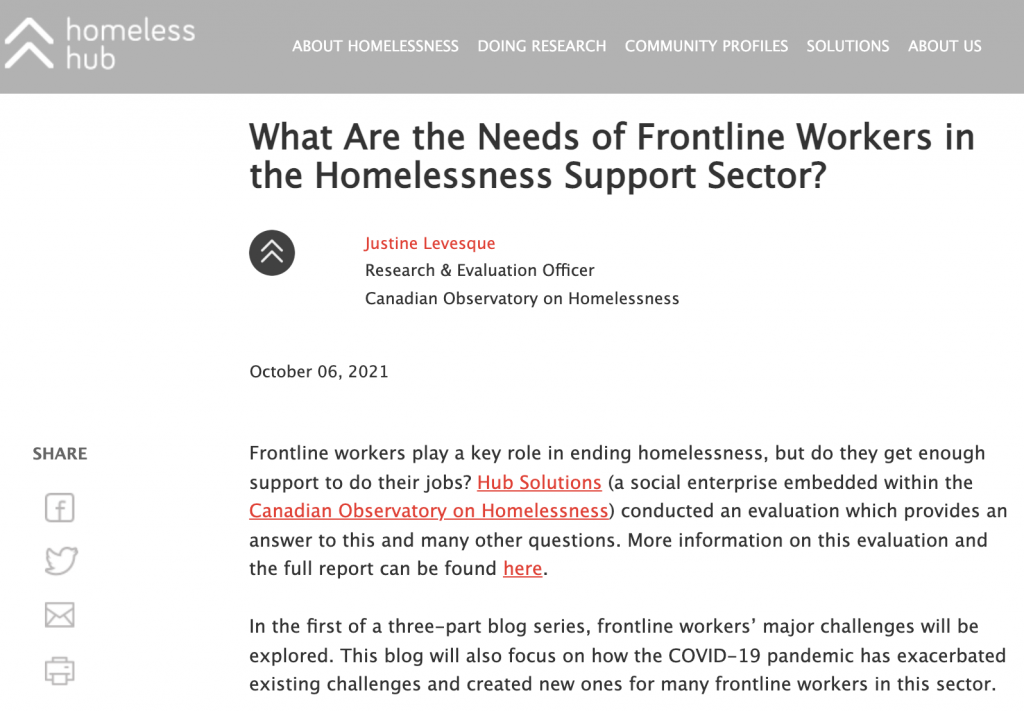3. How can support workers prevent becoming burned out?
If you have ever had a job, it is likely you have experienced some degree of stress related to your employment. Perhaps you have had to respond to upset customers, deal with a micro-manager boss always checking up on you, or clean up a super gross spill in aisle 3. Whatever the position, stress is a common part of having a job. However, feeling burned out goes beyond normal levels of stress one would expect to have at work.
When you hear the term “burnout,” what comes to mind? Why do you think it is more common in helping professions, such as Social Work, Emergency Response, and Health Care? Do you think it is an inevitable outcome of working in these fields, or are there approaches we can use to help support workers avoid it? Before you continue through this section, we invite you to respond to these questions using the space below. You may write as little or as much as you wish.
How to complete this activity and save your work: Type your response to the question in the box below. When you are done answering the question navigate to the ‘Export’ page to download and save your response. If you prefer to work in a Word document offline you can skip right to the Export section and download a Word document with this question there.
How can support workers prevent becoming burned out? This question could have been situated in multiple chapters of this book. Working in the homelessness sector, whether related to housing, mental health, physical health, emergency medicine, addictions, or frontline support work, can have a negative effect on service providers’ well-being over time. People often enter these professions with the goal of wanting to help make a difference in other people’s lives and they bring a great deal of enthusiasm and passion to the work. However, homelessness results from negative life circumstances and trauma which require on-going investments and support from professional care providers. The level of commitment required of support workers can be incredibly high and take a toll on their own sense of wellness. In the first video of this section, Dr. David Firang explains why he chose a career as a Social Worker and how reflexivity helps him manage the challenging aspects of the profession.
Dr. David Firang: How can support workers prevent becoming burned out?
In this video, Dr. David Firang argues that despite being a difficult and stressful career, Social Work can also be thought of as a helping profession. Social Workers may come from different cultures and backgrounds, and hold different values and beliefs than the clients they work with. To prepare their students for this, those who teach Social Work can provide training in anti-oppressive practice, diversity, equity, and inclusion. Once in the field, good social workers will reflect upon this education to better understand their own social location, identity, values, and beliefs, and to try to draw the deficit gap in order to relate with all their clients. This video is 2:43 in length and has closed captions available in English.
Key Takeaways – Dr. David Firang: How can support workers prevent becoming burned out?
- Being a Social Worker is recognized as a difficult and stressful career, but the people who do this work can also be thought of as helping professionals.
- Social Workers may come from different cultures and backgrounds and may hold different internalized values and beliefs than their clients. They must figure out how to relate to their clients despite these differences.
- Social Work educators can help prepare their students to undertake this difficult work by training them in anti-oppressive practice, diversity, equity, and inclusion.
- Once in the profession, a good Social Worker will use this training to reflect on their own location, identify, values, and beliefs, and then try to relate that to the client and draw the deficit gap to understand how to best relate to, and work with their client despite these differences.
Social Workers, and others in frontline homelessness related professions, provide care and support for people with complex needs. At the same time, we must consider what they themselves need in order to be able to undertake this demanding and important work. We invite you now to read the blog post written by Justine Levesque, Research and Evaluation Officer at the Canadian Observatory on Homelessness entitled, “What are the needs of frontline workers in the homelessness support sector?” This is the first in a series of 3 blog posts that report on findings from a recent evaluation. We encourage you to read the report that is linked to this blog as well, to learn more about the study and its findings.
Click the image below to open a new window and read the full blog post, “What Are the Needs of Frontline Worker in the Homelessness Support Sector?” by Justine Levesque.
While working in the homelessness sector can be very rewarding, it also can lead to post-traumatic stress disorder (PTSD), burnout, and discrimination as we saw in the blog post above. These feelings can emerge as support workers listen to the stories of their clients, make outreach visits to people in marginal spaces within the community, or lose clients to premature deaths related to poor health, drug overdose, or violence committed against them. The accumulation of stress from these circumstances can take a toll on support workers, who often care deeply about the people they support. Dr. Kelli Stajduhar explains this further in the next video.
Dr. Kelli Stajduhar: Workers, loss, and grieving
In this video, Dr. Kelli Stajduhar tells the story of walking into a colleague’s office to find her visibly upset. As a front-line worker she had experienced numerous losses. Although brief, Dr. Stajduhar’s impactful message in this video is that workers must recognize the impact of the loss they experience and understand it within the context of grieving. This video is 0:34 in length and has closed captions available in English.
Key Takeaways – Dr. Kelli Stajduhar: Workers, loss, and grieving
- Front-line workers are exposed to numerous losses in the course of their work. It is important that they recognize this loss and situate it within a larger framework of grieving in their lives.
Suffering continual losses can create feelings of grief in people working in frontline helping positions within homelessness sectors. Dr. Jeannette Waegemakers Schiff, who has extensively studied the impact of frontline work on service providers, argues in the next video that the term “burnout” is not sufficient to capture the severity. Rather, she notes that we should think of workers as having sustained a workplace injury.
Dr. Jeannette Waegemakers Schiff: Let’s change the way we think about burnout
In this video, Dr. Jeannette Waegemakers Schiff argues that workers deal with tremendous psychological and moral injury on a regular basis. Rather than referring to it as burnout, she suggests we should reframe the issue to see people having been injured as a result of the work they do. This would shift not only our understanding of the issue, but our responses to it as well. This video is 0:41 in length and has closed captions available in English.
Key Takeaways – Dr. Jeannette Waegemakers Schiff: Let’s change the way we think about burnout
- Workers have to deal with psychological and moral injury on a regular basis. Rather than talking about burnout, we should be reframing the issue as people having been injured as a result of the work they do. That would change the way we understand and respond to this issue.
The impacts of support work are complex and have to be understood in a dynamic way. For instance, Waegemakers Schiff and Lane (2019) have noted that while support workers may experience vicarious trauma, compassion fatigue, or burnout, researchers have not widely considered how they might be experienced collectively altogether. To address this, they undertook a survey of 472 frontline workers in homelessness agencies and found high rates of post-traumatic stress disorder (PTSD) related to their work directly with clients. We invite you to learn more about the study and its findings in the featured reading below. In the video that follows, lead author Dr. Jeannette Waegemakers Schiff, speaks about her follow-up study on support worker wellness in homelessness sectors during COVID-19.
Featured Reading:

Waegemakers Schiff, J., & Lane, A. M. (2019). PTSD Symptoms, Vicarious Traumatization, and Burnout in Front Line Workers in the Homeless Sector. Community Mental Health Journal, 55(3), 454–462.
Dr. Jeannette Waegemakers Schiff: How can support workers prevent becoming burned out?
In this video, Dr. Jeannette Waegemakers Schiff clarifies that burnout is not the issue, but rather it is traumatic stress that is harming frontline workers. She notes that current research indicates over half of homelessness sector workers across the country suffer from rates of traumatic stress that would qualify for a Post Traumatic Stress Disorder (PTSD) diagnosis. Dr. Waegemakers Schiff explains that with burnout people are disenchanted, lose compassion, and no longer care about helping people. In contrast, people suffering from traumatic stress continue to care but are unable to help because they suffer from psychological injury and high levels of depletion and stress. Having in-person contact with colleagues and supervisors can help lessen the effects of stressful working conditions, and research has shown service providers who worked remotely during COVID-19 particularly felt the effects of traumatic stress. In the absence of personal contact, Dr. Waegemakers Schiff argues it is important for workers to identify self-care strategies, such as meditation, that work for them. Managers and supervisors must recognize the signs of traumatic stress in their employees and implement approaches to help them. Dr. Waegemakers Schiff concludes that trauma-informed care is not just about how service providers look at their clients, it is also about how they look at themselves. This video is 6:33 in length and has closed captions available in English.
Key Takeaways – Dr. Jeannette Waegemakers Schiff: How can support workers prevent becoming burned out?
- Burnout is not the issue. Traumatic stress is much more prevalent in human service professions.
- Current research shows 51-56% of frontline workers in homelessness sectors across the country suffer from rates of traumatic stress that qualify for a PTSD diagnosis.
- Burnout means that people are suffering from feeling disenchanted and disillusioned, are cynical, and no longer care.
- With burnout, people’s compassion and sense of satisfaction from helping others goes down to being virtually non-existent.
- Comparatively, people experiencing traumatic stress continue to care but are suffering from a psychological injury as a result of the caring work they do.
- These individuals are also suffering from a moral dilemma of wanting to help but feeling so emotionally stressed and depleted that they are unable.
- Whereas people who are burned out have ‘checked out,’ those suffering from traumatic stress still want to help others.
- Support from, and engagement with, colleagues and supervisors can help buffer the effects of traumatic stress.
- During COVID-19, service providers who worked directly in the shelters had slightly lower rates of traumatic stress than their colleagues who worked remotely. This finding was surprising but may indicate that those in face-to-face settings have more control over their interactions than the availability expected of those working remotely.
- Personal contact with colleagues, such as taking a coffee break or going for a walk together are small ways that can reduce, if not completely remove, the stress a worker is feeling.
- In the absence of in-person contact, service providers need to find the self-care activity that puts them in a less stressful zone.
- Research has shown yoga and meditation can lessen the stress burden.
- We must help people identify and recognize that most frontline service providers have been through traumatically stressful events, and they need to learn how to cope with them.
- Part of the work of managers and supervisors is to recognize the existence of traumatic stress and implement ways to help their staff.
- Just like measures are put in place to protect physical injury in the workplace, measures are needed to protect against psychological and moral injury.
- Trauma-informed care is not just about how a service provider looks at a client, it is also about how they look at themselves.
- Workers must recognize and state when they need time out. It is not a sign of weakness to admit one needs help, nor is it super-human to keep going when one cannot.
What do you think?
 Dr. Waegemakers Schiff explained that traumatic stress is a more pressing issue than burnout, because with burnout people no longer care. With traumatic stress, they still care but are unable to accomplish what they feel they need to do. In our everyday language as a society, we tend to use “burnout” as a catch-all for people who are feeling overwhelmed and over-burdened at work. Do you agree with Dr. Waegemakers Schiff that we should be more precise with the language we use to describe people’s experiences? Why do you think “burnout” has become the collectively preferred term over the more accurate “traumatic stress?”
Dr. Waegemakers Schiff explained that traumatic stress is a more pressing issue than burnout, because with burnout people no longer care. With traumatic stress, they still care but are unable to accomplish what they feel they need to do. In our everyday language as a society, we tend to use “burnout” as a catch-all for people who are feeling overwhelmed and over-burdened at work. Do you agree with Dr. Waegemakers Schiff that we should be more precise with the language we use to describe people’s experiences? Why do you think “burnout” has become the collectively preferred term over the more accurate “traumatic stress?”
In this section, we use the term “burnout” because of its widespread recognition, but we are also very aware that it does not capture the complexity of people’s experiences. For that reason, we also refer to traumatic stress, compassion fatigue, and grief as well. We encourage you to note when these different terms arise and the meanings behind them. Burnout, compassion fatigue, and traumatic stress are all prevalent experiences for people working in frontline support roles with individuals experiencing homelessness. This was particularly evident during COVID-19, as homelessness sector workers self-reported rates of mental health problems that were similar to those of health care practitioners (Kerman, Ecker, Gaetz, Tiderington, & Kidd, 2021). When service providers do experience these mental health issues it is important to note it is not because they lack individual coping skills. Rather, these issues arise from the structure of the work itself and not having institutionalized practices aimed at identifying and reducing these problems amongst workers.
Malenfant, Nichols, and Schwan (2019) have written about the emotional and relational work that occurs within homelessness sectors and argue that whether people’s work is recognized and valued within an organization is critically important. In the concluding section of this article, they write, “It is the valuation of the work within organizations that contributes to shifts in social policies, practices, and people’s experience and pushing back against the erasure of connections between the daily work of people – that work that goes into maintaining all the moving pieces of an organization – that should be recognized as a key part in the process of contributing to social change” (Malenfant et al., 2019, pg.53). In this next video, Dr. Naomi Nichols, co-author of this study, discusses how these mental health challenges are structural issues that have been exacerbated during the COVID-19 pandemic.
Dr. Naomi Nichols: How can support workers prevent becoming burned out?
In this video Dr. Naomi Nichols argues that burnout occurs in care sectors when people try to do their jobs without adequate resources, leading them to have to work in ways that conflict with their values. For instance, during the COVID-19 pandemic the need for services rose while the provision decreased, causing social workers to shift towards planning rather than doing. Dr. Nichols argues that while burnout is a structural issue, it is felt as an adjustment disorder at the level of the individual body. People who work in frontline services may themselves have previous experiences of homelessness, be paid low wages for the work they do, and be under economic pressures that exacerbate the work-related stress they experience. This video is 6:38 in length and has closed captions available in English.
Key Takeaways – Dr. Naomi Nichols: How can support workers prevent becoming burned out?
- Burnout in care sectors arises when people try to do their jobs without adequate resources, leading them to have to work in a way that conflicts with their values.
- During COVID-19 many social workers were close to, or experienced, burnout because their job is to connect clients to services and resources that were unavailable.
- The pandemic caused a shift towards planning rather than doing. The need for supports kept growing while the provision decreased.
- The systemic pressures create outcomes that are felt at the level of the individual body.
- The stress is caused by structural issues, but registers as an individual pathology known as an adjustment disorder.
- Part of the work of attending to burnout is acknowledging the roots of it in ways that do not make people feel like it is their fault.
- People who work in frontline services may themselves have previous experiences of homelessness, be paid low wages for the work they do, and be under economic pressures that exacerbate their work-related stress.
It is clearly evident that frontline support work is challenging. This does not mean that people should not undertake this kind of employment, but rather that when they do they need to have appropriate supports in place for themselves. Researchers have written, “Stress and trauma are often side effects of front-line youth work. While these issues cannot be totally eliminated, strategies and practices are emerging to deal with them. Interventions that have been shown to reduce stress, burnout, compassion fatigue, and vicarious trauma are psychoeducational and skill-based, and involve training in mindfulness, cognitive behavioural therapy, and psychological first aid. Mental fitness, self-care practices, and robust social supports serve as protective factors” (Cerswell Kielburger, Rockman, & Baranek, 2018, pg. 171).
As the guiding question for this section, we asked you to consider how support workers can prevent becoming burned out. There are many steps that support workers, and their supervisors, can take to reduce burnout, compassion fatigue, and traumatic stress related to frontline work within the homelessness sector. Consider this TEDx talk entitled, “How to manage compassion fatigue in caregiving” by Patricia Smith. While this video is not about working in the homelessness sector, the key points are highly relevant. We encourage you to think about how the concepts could be used to improve the well-being of Social Workers and others who undertake support roles related to homelessness.
What do you think?
We have heard from different people discussing issues related to burnout, compassion fatigue, and traumatic stress. Have you ever experienced these in your own life? What strategies have you used to cope with these feelings?
There are many specific approaches that can be used to reduce the risks of support workers becoming burned out, feeling compassion fatigue, or experiencing traumatic stress. These approaches exist at both the individual and workplace levels. In the two videos that follow Dr. Jeff Karabanow and Dr. Nick Kerman both discuss steps that support workers and managers can take within homelessness sector agencies to reduce the negative mental health burdens on employees.
Dr. Jeff Karabanow: How can support workers prevent becoming burned out?
In this video, Dr. Jeff Karabanow explains that frontline service provision entails emotional labour and that while people enter the field because they care deeply, they are faced with discriminatory and oppressive structures that can lead to compassion fatigue. He notes that while there are some strategies individuals can use, such as exercising and eating well, preventing burnout should not be left to individuals. Rather, Dr. Karabanow argues that organizations should support their staff by being deeply intentional about check-ins, time off, holding team meetings, offering training and educational leaves, and offering supports that help workers feel connected. Burnout can come on quickly, particularly with the stresses of COVID-19, and organizational leaders can help by engaging with staff to show they are listening and willing to work together to identify and implement solutions. This video is 5:13 in length and has closed captions available in English.
Key Takeaways – Dr. Jeff Karabanow: How can support workers prevent becoming burned out?
- Frontline service provision entails huge amounts of emotional labour. People enter the profession because they care deeply and are passionate about helping others, but they deal with discriminatory and oppressive structures which can be exhausting and lead to compassion fatigue.
- Organizations can support their staff by being deeply intentional and strategic about how they support their employees. This includes intentional check-ins, time off, team meetings, training and educational leaves, and supports and strategies that help workers feel connected.
- Burnout can come on quickly if a worker feels they are carrying a lot of pressure without support. Research shows that people working in the non-profit sector during COVID-19 have been even more strained and overburdened than usual.
- There are some strategies individuals can use – such as exercising, eating well, engaging in yoga, and doing sports – but preventing burnout should not be left to individuals.
- Organizational leaders need to engage with staff to show they understand the issue, are listening, and are willing to work together to identify and implement solutions.
Dr. Nick Kerman: How can support workers prevent becoming burned out?
In this video Dr. Nick Kerman explains the importance of boundary-setting for service providers, to avoid burnout. He notes that good boundary setting means not taking calls or emails while off work and trusting that a team member who is on duty will be able to handle situations that arise. Dr. Kerman notes that boundary setting allows service providers to rest and recharge. He argues that organizations have a role to play in supporting workers avoid burnout. Strategies they can use include offering flexible time off, increasing wages to reflect the importance of the work, and ensuring supervisors are prepared to recognize and respond to stress and trauma in their employees. This video is 4:47 in length and has closed captions available in English.
Key Takeaways – Dr. Nick Kerman: How can support workers prevent becoming burned out?
- Setting boundaries between one’s professional and personal life is particularly important for service providers because the work can be stressful and emotionally laden.
- Having good boundaries means not taking calls or responding to emails when off work and trusting that a team member who is working will be able to handle situations that arise.
- Boundary setting helps service providers to rest so they can respond to client needs when they are back at work.
- Organizations have a role to play in preventing service provider burnout.
- One good strategy is offering employees flexible time-off with no questions asked.
- Support workers are often underpaid for the demanding jobs they do. Increasing wages communicates that this work is important.
- Frontline workers need supervisors who recognize and can help them respond to the trauma and stressors inherent in their jobs.
Identifying resources and champions within an organization can increase awareness of the need for mental health promotion and strategies for reducing burnout and its associated challenges (Cerswell Kielburger et al., 2018). This brief video from the National Alliance to End Homelessness shows the measures that three homelessness sector agencies implemented to protect their frontline support workers through the COVID-19 pandemic.
There are many different approaches that support workers and their managers can take to reduce the impact of burnout, traumatic stress, and compassion fatigue. As we have heard, it is best to select the ones that resonate and it can be useful to start small (Cerswell Kielburger et al., 2018). We end this section with a hopeful message from Dr. Nick Kerman, about the importance of recognizing and celebrating the small wins in frontline support work.
Dr. Nick Kerman: Recognizing the small wins
In this video, Dr. Nick Kerman argues that working in the homelessness and supportive housing sectors can be stressful and demanding, because service providers are often helping clients work towards achieving long-term goals. He notes that one of the best, yet overlooked, approaches for service providers to avoid burnout is to focus on the small wins. These are moments that occur daily, such as when a client smiles despite usually being withdrawn, shows up for an appointment despite competing obligations, and/or fills out an application for housing or employment. Dr. Kerman encourages service providers to be mindful of small wins because they show a client feels supported, has formed a trusting relationship, and is making progress. This video is 2:38 in length and has closed captions available in English.
Key Takeaways – Dr. Nick Kerman: Recognizing the small wins
- Working in the homelessness and supportive housing sectors can be stressful and demanding.
- Service providers are often working towards helping clients achieve long-term gradual goals, like moving into stable housing.
- Working in an environment where ‘wins’ happen intermittently can be challenging but there are ways to help service providers avoid burnout.
- One approach that can be very beneficial for service providers is recognizing the ‘small wins.’
- Small wins are moments that happen every day that show a client is feeling supported, that a relationship has formed, and/or that they are engaged and moving towards greater stability.
- Examples of small wins include having a client who is withdrawn smile or say hello, when a person shows up for a scheduled appointment despite having multiple competing obligations, and having a client fill out applications for housing, employment, or other supports.
- The small wins may often be overlooked but it is important to be mindful of them because they show progress has occurred.

In this section, we explored the question, “How can support workers prevent becoming burned out?” We began by considering the challenging nature of support work with people experiencing homelessness, and saw that people enter this profession with a sense of passion and purpose. Over time, the accumulation of stress and loss can lead to feelings of grief which is akin to a workplace injury. We heard that the term “burnout” – while commonly used to describe a wide array of feelings – does not capture the full extent of what support workers experience. Rather, traumatic stress and compassion fatigue were emphasized as being terms that better capture the mental health impacts that can result from this kind of support work.
While these mental health outcomes may be felt at the individual level – by workers themselves – we emphasized that this is not an individual level deficiency. Rather, we heard from researchers that burnout, traumatic stress, and compassion fatigue are rooted in organizational practices. This suggests that workers may suffer more in workplaces where they feel undervalued, but also that employers can implement practices to help buffer these effects faced by their staff. We heard from a number of researchers that there are many strategies individuals can use, such as journaling, exercising, and boundary setting, as well as strategies managers can take to reduce mental health burdens, such as through team debriefings and regular check-ins with staff. The key is to find the approach that works for the individual and/or their team. Taking time to notice and appreciate the small wins is where we ended the chapter, but it is a great place to start one’s wellness journey.
Podcast: How can support workers prevent becoming burned out? (30:54)
Click the link below to listen to all of the researchers answer the question “How can support workers prevent becoming burned out?” in audio format on our podcast!




